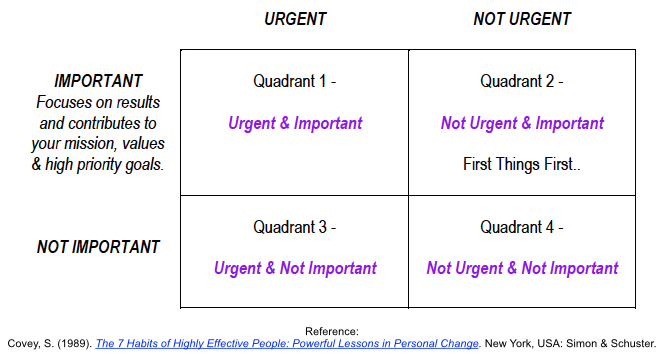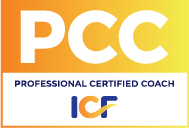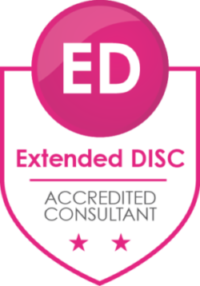Do You Put First Things First?
Putting first things first means having self-awareness and knowing yourself – your priorities, values, mission, vision, dreams and taking actions towards those each day.
If not, don’t worry you are not alone! Many of us get trapped in to unconsciously spending time on activities that are not essential or important in our lives and forget to take time out and consider the bigger picture – i.e. our mission. This can lead to regrets later in life and not fulfilling our potential or sharing our purpose.
In order to master our time and lives so we can live whole-heartedly, we need to become aware of OUR own essential needs and priorities. The framework I am going to share with you to help you put first things first, is called the Time Management Matrix that was shared in a book by Stephen Covey (however originated from Dwight Eisenhower).
“Organise and Execute Around Priorities.” ~ Stephen Covey
The Time Management Matrix is a fourth generation of self-management (or some refer to it as time management). The first three generations of time management according to Stephen Covey have been –
- First generation – focused on notes and checklists and tried to recognise the many demands on our time and energy.
- Second generation – focused on calendars and appointment books and help us look ahead to future activities and events.
- Third generation – is the one many people use today. The third generation is about identifying our values and prioritising, planning, controlling and taking daily steps toward those goals – being very efficient. What many people are waking up to, is that this time of system can be counterproductive and by focusing of efficiency we can miss out on meeting our human needs as well as opportunities to develop deeper relationships.
The first three generations focus more on things and time. The fourth generation – the Time Management Matrix as outlined by Covey focuses on enhancing relationships and results. These tasks and relationships are identified through the quadrant in which they fall.
The Time Management Matrix: 4 Quadrants
You can see in the Time Management Matrix, each day our activities can be broken down in to urgency and importance.

Quadrant 1 – Urgent and Important:
In Q-1 we deal with the urgent and the important – significant results that require urgent attention. What are your crisis, problems and/or emergencies? They are located in this quadrant. We all have these in our lives, however the difference is people who are mainly in Q-1 it is the focus of their life. Some of the results of spending too much of our time here include burnout, stress and continually just putting out fires instead of being proactive.
Quadrant 3 – Urgent and Not Important:
In Q-3 we deal with the urgent and not important. People who spend too much time in this quadrant, spend most of their time reacting to things that are urgent and assume important. Some of the results of spending too much in this quadrant include focusing on other people needs, feeling victimised, lack of focus on your goals, crisis management and shallow or broken relationships.
Quadrant 4 – Not Urgent and Not Important:
In Q-4 we deal with the not urgent and not important. The results of spending too much time in this area can be disengagement from life, irresponsibility and dependent on other people and institutions for their basic needs.
Quadrant 2 – Not Urgent and Important:
In Q-2 we deal with the not urgent and important. This quadrant is the heart of effective personal management. Activities that are completed in this quadrant include building relationships, writing a personal mission statement, nurturing your health and activities you know you need to do to maintain your life. The results of spending time here include your vision, mission, focusing on what you can control, discipline and commitment.
Questions for Reflection –
As you look at the time management matrix, identify –
- Where do you think you spend most of your time in Q-1, Q-1, Q-3 or Q-4? To check in with your perceptions – draw a time management matrix and then log your time for the next 3 days in 15-minute increments. Then check – were your perceptions are accurate?
- What is one habit you could change to alter the results you are getting in your personal life?
- What is one habit you could change to alter the results you are getting in your professional life?
“The key is not to prioritize what’s on your schedule, but to schedule your priorities.” ~ Stephen Covey
Feel free to share any questions below or on our Facebook page here.
If you are ready to take yourself on the adventure of getting to know yourself (your true self), why not join the Toolkit? A place where I share tools, inspiration and ideas to live a courageous and openhearted life.
Reference –
Covey, S. (1989). The 7 Habits of Highly Effective People: Powerful Lessons in Personal Change. New York, USA: Simon & Schuster.

















2 Comments
[…] Put First things first! […]
[…] If you haven’t learned about The Time Management Matrix in 7 Habits, you need to. Read more here. It is an excellent guide to prioritize your daily tasks into what actually has impact on your life […]
Leave A Response